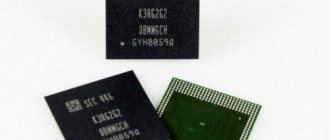The word "accelerometer" is of Latin origin - "accelero", which literally translates as "I accelerate". It is used to measure apparent acceleration. That is, if we talk about the accelerometer in the phone, then its responsibilities include helping the software determine the position of the device in space. It happens that this device is often confused with a gyroscope, but this is not so, these devices complement each other perfectly and in some cases can be interchangeable. Their main difference lies in the principle of operation; their combined use allows you to achieve the most accurate measurements. A synonym for the accelerometer in a mobile device is the G-sensor.
What is an accelerometer on a phone?
This term originally comes from the Latin word “accelero,” which literally means “I speed up.”
A device called an accelerometer is used to measure the apparent acceleration, or the difference between the gravitational acceleration and the true acceleration of a physical body or object. Another name for the device is G-sensor. Implementation of the function in a smartphone involves determining the angle of inclination of the device relative to the surface of the earth by comparing three coordinates: X, Y and Z, or width, length and height, respectively.
Special software is responsible for changing the orientation of the image on the screen depending on the coordinates received by the sensor.
But a “smart” device with a compact size (less than a 10-kopeck coin) is capable of responding not only to changes in the position of the body in the coordinate system. Additionally, it senses external influences such as shaking, pushing or turning. Depending on the settings of software processes and the requirements of the installed application, each action generates a response.
Each smartphone has another sensor that can detect changes in the angle of inclination, which is called a gyroscope. Its task is identical and consists in determining the position of the device relative to the earth's surface. Modern devices, to improve their performance, use data received from two sensors at once, so we can say that they complement each other.
Principle of design and operation of the sensor
In its classic design, this small-sized sensor has a simple design and consists of three components: a spring, a moving mass and a damper.
The spring is fixed to a fixed frame. A weight or mass is attached to its free end, the movement of which is limited by a damper, necessary to dampen the vibrations created during swinging.
When acceleration occurs, a movement of the mass is observed, leading to deformation of the spring, which is recorded by a measuring unit that converts these vibrations into specific values.
Upon completion of the manipulation, due to the spring, the inert mass takes its original position. The sensor is needed to record changes in the displacement level relative to the rest state.
Also, when it comes to an accelerometer, such a concept as the sensitivity axis of the device is introduced. There are three of them in total, according to the number of components of the coordinate system. If there is one axis, the built-in sensor will be able to transmit a change in position only within the sensitivity of a given coordinate.
For your information!
To achieve normal operation, three sensitivity axes are required, then a full calculation of changes in the position of the device in a three-dimensional coordinate system occurs.
Modern mobile devices are small in size, as each manufacturer tries to make their flagship ultra-thin. Therefore, it is not possible to place a classic accelerometer inside the case. It is replaced by a small microcircuit, inside of which there is an inert mass, but there is no spring in the standard sense, although sensitive sensors can clearly detect changes in the angle of inclination of the device.
Sensors for accelerometers are manufactured automatically using robotic machines. To obtain a working copy, a chemical reaction is required in which silicone and other elements interact. Since quality and accuracy will depend on the correctness of calculations and proportions, it is impossible to achieve this through physical influence in conditions of such a minimum size.
Principle of operation
The main principle for equipping modern phones with this device is compactness, since many smartphones have a body thickness of no more than eight millimeters, and it must accommodate a huge amount of different electronics. That is why the developers created a miniature accelerometer design, which was placed in a special chip.
The principle of its operation is that a partition is attached to a stationary body with conductors set aside, which are placed between the contacts that read acceleration changes.
It is almost impossible to create such miniature versions of the device manually, so they are made on automated conveyor lines, and reactions of silicone and other substances are taken as a basis.
Accelerometer functions and their applications
The presence of this sensor in a smartphone is quite a useful feature, since it can improve the comfort of using the device.
For your information!
A person who has experienced the beauty of a phone with an accelerometer will no longer be able to use outdated models that do not have a G-sensor, due to the lack of important functions that are already familiar in the modern world.
Pedometer
The first use for an accelerometer will be to use it to determine the number of steps taken. This feature will be useful for sports enthusiasts or people involved in fitness. Also, a large number of modern phones have applications that allow you to monitor your own health, which always includes a pedometer. The accuracy of the readings is not perfectly accurate, but it allows you to adjust your own training regimen to increase their effectiveness.
Game controls
Another important function is the ability to control the gameplay by changing the angle of inclination. This is especially convenient in racing games, where a smartphone with an accelerometer will replace a steering wheel connected to a laptop or desktop PC in order to simplify the process and feel more immersed in the game. The effectiveness of control will depend on the amplitude of the movements performed.
Auto-rotate screen
Viewing a photo or video becomes more comfortable when you change the screen orientation to landscape. This simplifies the perception of information and allows you to strain your eyes less. The accelerometer is responsible for this process. Also, by changing the position of the picture on the screen, it becomes easier to work with documents or spreadsheets.
Improved navigation
The built-in accelerometer improves the geopositioning of the device in space. This may be necessary when operating even the simplest compass, which will respond to changes in the device’s position relative to the coordinate system.
Physical control of the smartphone
Some modern flagships have the ability to control the operation of individual built-in applications through gestures or changing the position of the device. The accelerometer is used to change the music player track, turn off the alarm clock, and turn off the sound of an incoming call when turning the device screen down.
For your information!
In most cases, physical control of the smartphone should be activated in the settings, for which you should first carefully read the operating manual or the advice of the internal assistant.
Enable or disable the feature
The auto-rotate screen feature is not always enabled by default, so you need to change your smartphone settings to activate the accelerometer. This can be done in two ways:
- By going to the settings menu, where you need to select the “Screen” item and simply enable automatic screen rotation when the device’s position changes.
- By activating the desired icon through the notification shade, where there are icons for quick access to certain functions. Auto-rotate screen is depicted in the form of a slightly tilted smartphone and stylized strokes indicating movement.
At some points, automatic image changes will interfere. To disable this feature, you can use the methods above.
Fixing the problem is very simple - you just need to notice it
To summarize the article, we can safely conclude that the accelerometer, in fact, can be used just as fully for surveillance as the same geolocation services. It can be an excellent tool for both regular espionage and for creating a digital fingerprint of the user, allowing you to show him targeted advertising and even manipulate his emotions using the same advertisements.
Yes, many of the above methods of tracking through an accelerometer work more hypothetically than in reality, but the fact remains a fact. The strangest thing is that the solution to all this is quite simple - you just need to protect access to movement tracking sensors with a system permission, as is the case with Bluetooth or location detection. Most likely, this has not yet happened solely because the problem of unhindered access to the accelerometer has become prominent only recently - previously the media wrote little about it, and operating system developers who were already overloaded with worries simply did not attach any importance to this problem. We can assume that everything will change in iOS 14 and Android 13 - at least, I would really like it to.
Sensor calibration
If there is a problem with the correct operation of the sensor, it should be configured and calibrated. This is a fairly simple process that is automated and will require the user to perform a minimum of actions:
- Downloading a free application from PlayMarket.
- Place the smartphone on a flat surface.
- Enable the utility and go to the “Calibration” item.
Next, the entire process occurs automatically, with the user notified of its completion by the appearance of a corresponding inscription.
How to setup?
All modern gadgets are equipped with an accelerometer; if it is not there, this indicates either a very budget smartphone model, or that it was released many years ago. In order to add an acceleration control sensor, new firmware or changes in settings will not help; if it was not implemented during the assembly process, then nothing can be done about it.
If it was built in initially, then its functions simply need to be adjusted in the settings. To do this, go to Google Play and download any calibration application. After that, launch the program, place the smartphone on a flat surface and go to the utility settings, select the “accelerometer calibration” column. After such actions, a notification should appear on the screen, which must be confirmed, after which the setup will begin.
Accelerometer does not work: what to do
There are situations when the sensor stops working correctly or refuses to function at all even after calibration. The problem may be caused by a software glitch or a failure of the chip itself. Depending on the reasons for the occurrence, a different approach to troubleshooting is required.
Software glitch
In this case, the user should remember the last installed applications that could cause a hardware or software code conflict. The first step is to remove all new applications and try out the accelerometer.
If these steps do not lead to the desired result, then the second option to solve the problem is to reset to factory settings.
For your information!
Before performing this operation, you must copy all necessary and important information from the device’s memory to a computer or cloud storage.
To reset your phone to factory state, follow these steps:
- go to the smartphone settings menu;
- select “Backup and reset”;
- activate the “Reset to factory settings” button;
- confirm the action.
After some time, the user receives a completely restored phone in the same condition as it was in after purchase.
Another way to “cure” a software failure is to update the firmware. In this case, it is advisable to connect the smartphone to a WiFi network, since the new firmware can “weigh” gigabytes. To update the software, you need to go to the “Phone Information” menu item, then select the “Software Update” line. A check for new versions will follow and, if they are available, the user will only have to download them to the device and complete the update process.
Hardware failure
The second reason why the accelerometer may stop working is a hardware failure. The only way to restore normal functioning is to contact a specialized workshop, where, after carrying out diagnostic measures, the technician will decide what type of repair is required. Most often, the part is replaced with a new one, after which the operation of the device is restored.
The accelerometer is an important part that is necessary for convenient use of a modern smart device. Also, similar devices are used in the space industry and industry to control vibration. You can find an accelerometer in a hard drive, where it is used to protect against falls or shocks. Once again, you can find out what it is from the presented video.











